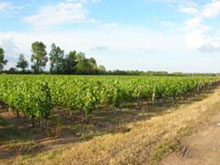
Vins
des Sables
Vines
Born of the Sand are Poised to Conquer Palates Around the World
|
Sandy
Vineyards in Aigues Mortes, France |
Picture
a vineyard. Thinking of some lush California
hillside with plenty of green? A lot of wine is actually grown in
barren sand. Since 1979, a small region in Provence’s
Bouches-du-Rhône, which extends from the Gard Coast to the
waterfront village of Saintes Maries de la Mer, has been known for
producing rosés grown in its sandy and rocky soil. For these
wines, sand is as much of an ally as are the sun and the wind. In
fact, sand allows the grapes to escape the threat of phylloxera,
a sap-sucking insect that rages through the vineyards here. Additional
protection comes from a network of about a hundred kilometers of
soft-water canals. These waterways also protect the Phoenician juniper
and the laughing frog plants that make up rosé’s distinct
terroir. Altogether, this region is home to 2,000 acres of vineyards,
1,500 of which are dedicated to the “Vins des Sables,”
or wines of the sand, whose production is approximately 50 million
bottles a year. We’re talking mostly rosé, vin gris,
or the very pale gris de gris.
In
2005, the Champagne
group Vranken-Pommery-Monopole (the world’s second largest
Champagne group and famous for posh brands such as Heidsieck
& Co. and their signature, Pommery)
took over the vineyards, thus becoming the largest worldwide producer
of rosé and establishing themselves as prime distributors
of “Vins des Sables.” The group, in partnership with
Listel, has created a few prestigious vintages such as the light
Pink Flamingo and Franc de Pied, a gris de gris. Both were awarded
silver medals at the 2006 International Rosé Fair in April
2006 in Nice,
and seem destined to put “Vins des Sables” on a world
map.
 |
| Sandy
Vineyards of Bourgueil |
The
Gulf of Lion doesn’t have the monopoly on these sand-born
offerings, and the vintners of Vranken-Pommery-Monopole aren’t
the only ones growing grapes in sand. On the Landes Coast in the
Southwest of France,
similar vineyards are situated between sedimentary dunes and sandy
plains, producing reds with notes of violet and heather and perfumey
whites and rosés.
Elsewhere
in Europe, south of Hungary’s
Great Plains, in the region of Pusztamerges and de Morahalom, the
sandy soil has been retained by vines since the 18th century, producing
light and fruity wines. However, the Italian “wines of the
sand” have the most in common with the ones from the Gulf
of Lion. They are grown on sandy marshes in the province of Ferrare,
the coastal band that extends south of Venice
and the city of Goro to the Po River. The principal grape is the
“uva d’oro,” or golden raisin, transported there
from Burgundy
by Renée de France, daughter of Louis XII, when she was married
in 1528 to the Duke of Ercole. Four of the wines that are produced
in this fertile region have just been given DOC (Denominazione di
Origine Controllata) status: Fortana, Merlot,
Cabernet Sauvignon and Bianco del Bosco. Fruity and light, these
wines marry perfectly with some of the other natural resources of
these marshes—game and fish, especially grilled eel.
*
Aigues Mortes photo by www.Avignon-et-Provence.com.
Bourgueil Vineyard photo by bourgueil.dufresne.free.fr
| P091306 |
(Updated:
09/25/06) |
|
